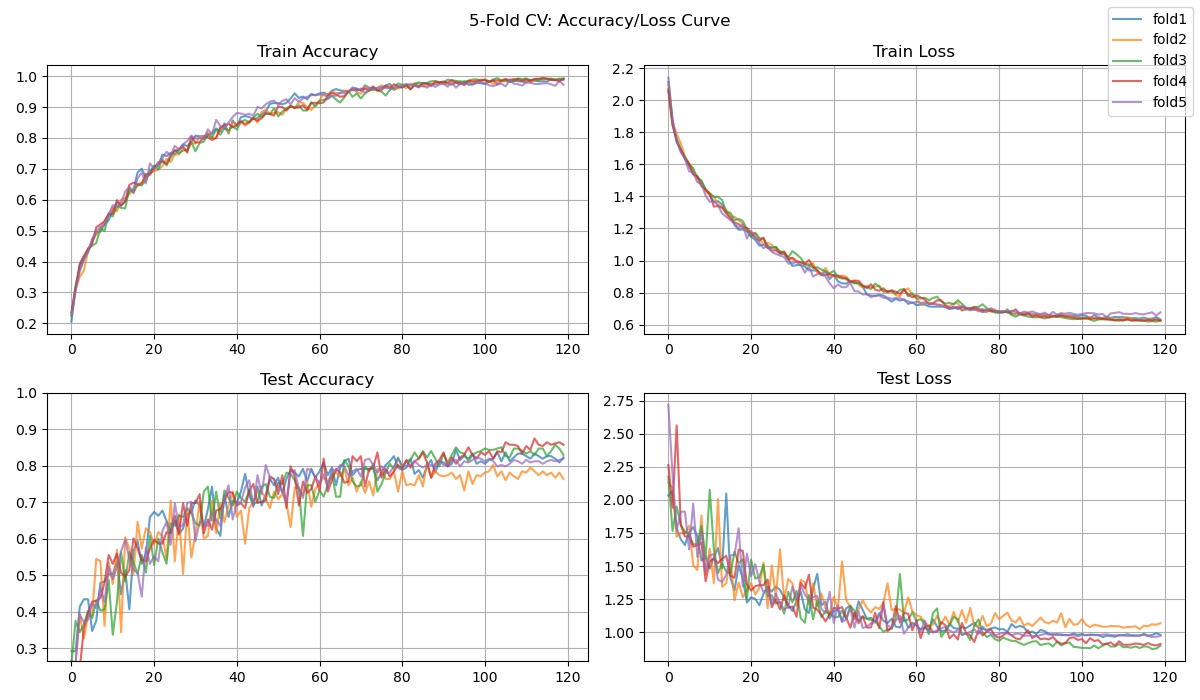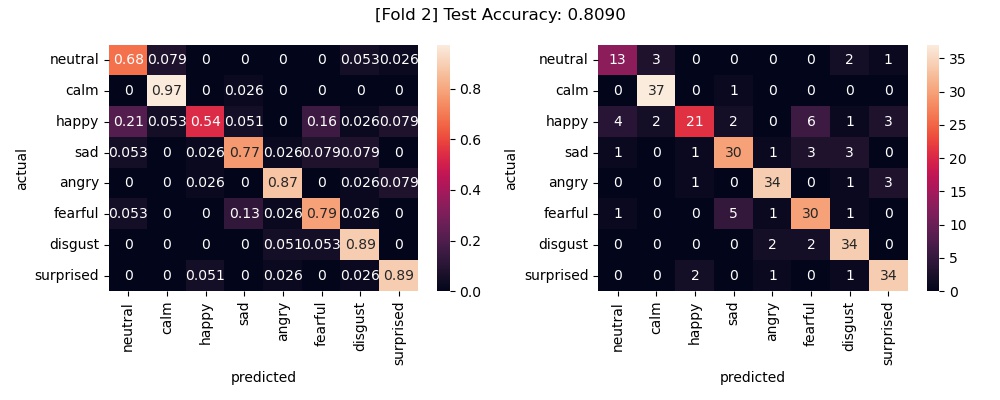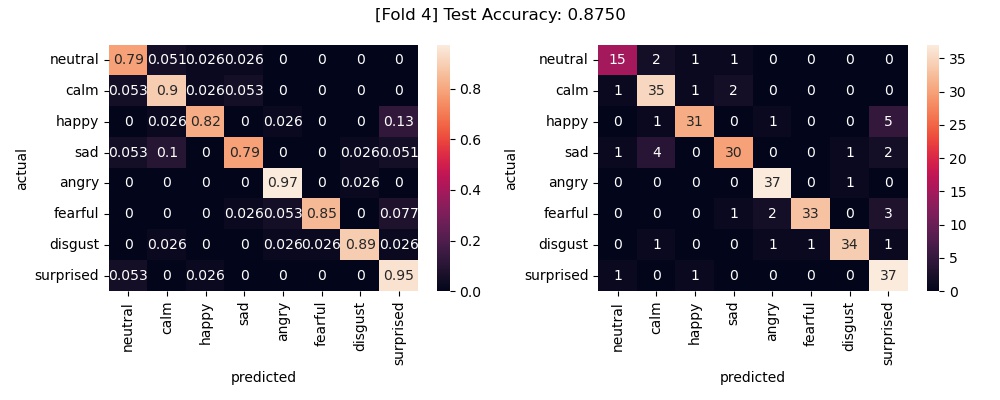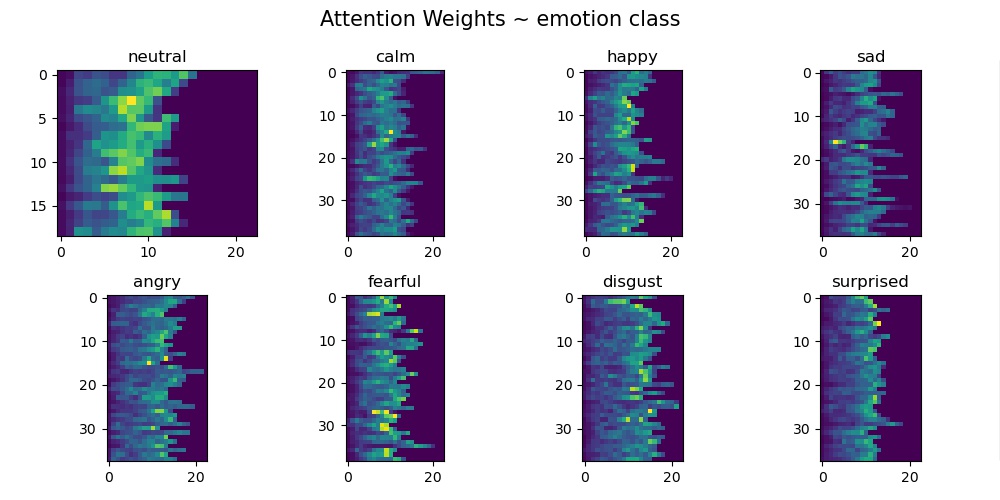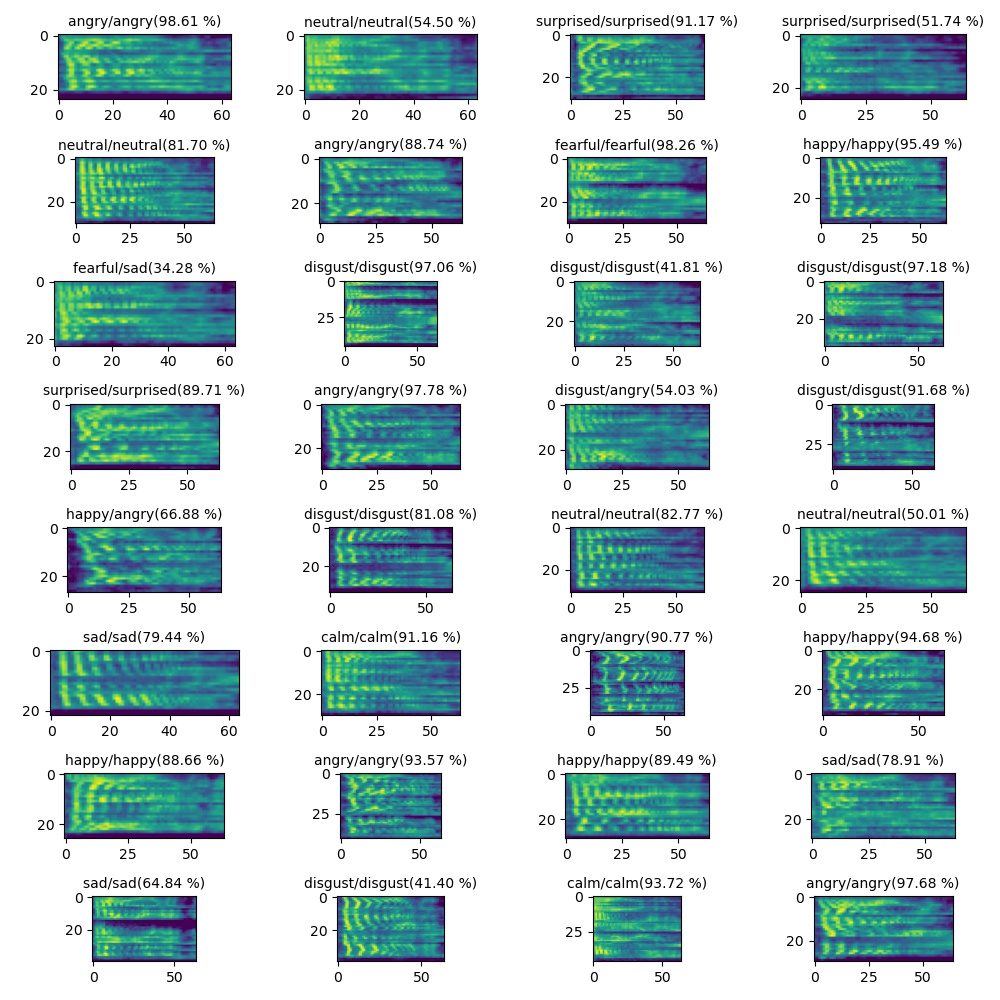- Convolutional part includes 3
ConvBlockfor extracting local information from mel spectrogram input.
ConvBlock:Conv1d -> ConvLN -> GELU -> Dropout - The returned output of Convolutional part goes through
Maxpool1dandLayerNormalization. GRUpart extracts global information bidirectionally.GRUhas an advantage in handling variable-length input.BahdanauAttentionis applied at the end ofGRU. This enables the model to know where to pay attention.
✅ Best test accuracy 87.15% on a hold-out dataset. (During the last 10 epochs, mean accuracy was 85.26%).
- train/test dataset with a proportion of 8:2.
- Stratified sampling from the emotion class distribution
- Mean test accuracy of 84.17(± 2.36)% in Stratified 5-fold cross-validation
✅ To increase the computational efficiency, VAD(Voice Activity Detection) is applied in the preprocessing stage.
- The start and end points are obtained from power of mel spectrogram.
- This process helps the model to learn features of the voiced region. There cannot be any emotion in the silent regions(before/after speech), hence they are excluded from analysis.
- Speech audio-only files from Full Dataset
- With 8 emotion classes: neutral, calm, happy, sad, angry, fearful, surprise, and disgust
- View more dataset information here
- Without augmentation or extra-dataset
- Loss function:
LabelSmoothingLoss(source) - Optimizer:
adabelief_pytorch.AdaBelief(source) - Scheduler:
torch.optim.lr_scheduler.ReduceLROnPlateau - Please check
train.pyfor more detailed hyper-parameters.
Best Test Accuracy: 87.15% / Loss: 0.86552
Train Accuracy: 0.98881(± 0.00367)
Train Loss: 0.63214(± 0.00590)
Test Accuracy: 0.85262(± 0.01182)
Test Loss: 0.86931(± 0.01257)
- ❗️The mean accuracy during the last 10 epochs may be more reliable to us than a simple best accuracy.
- We can see the confusion matrix(8 x 8). Rows represent the actual emotion classes while columns represent the predicted classes.
- Normalized confusion matrix shows recall for each emotion class.
- Accuracy metric is the same as WAR(Weighted Average Recall) since I did stratified sampling.
- ❗️ We can see that the the model is most confused about the happy class.
Due to the small size of the dataset, there was a concern that the hold-out output might be biased, so I attempted to perform 5-fold cross-validation.
[Fold 1] Best Test Accuracy: 0.84375 / Loss: 0.97918
[Fold 2] Best Test Accuracy: 0.80903 / Loss: 1.04934
[Fold 3] Best Test Accuracy: 0.85764 / Loss: 0.87293
[Fold 4] Best Test Accuracy: 0.87500 / Loss: 0.90747
[Fold 5] Best Test Accuracy: 0.82292 / Loss: 0.98223
[5-Fold CV Best Test Accuracy] max: 0.87500 min: 0.80903 mean: 0.84167 std: 0.02361
- ❗️ The mean test accuracy is approximately 84%, which is slightly (almost 3%p) lower than the hold-out result, but overall showing good performance.
- ❗️ One drawback is that there is significant variation in test performance across folds, which could be due to shuffling of the data, but it could also be a reproducibility issue with the optimizer.
- The worst-performing and best-performing output are compared through the following figure.
- The confusion matrices for all folds can be found in
/output/cv5/img/
- ❗️ There was a significant gap between the highest and lowest values, especially the accuracy for "happy" class was notably low.
- With EmoCatcher, I achieved a test accuracy of 87.15% on a hold-out dataset and mean test accuracy of 84.17% under 5-fold CV.
- I have personally tested this on the CPU. According to the PyTorch documentation, it is not guaranteed that output will be reproducible across different devices. Since I haven't conducted many experiments yet, I think more experiments should be carried out to find consistent parameters to increase reproducibility of the above output.
- There was overfitting of the train data, which was probably due to small dataset size. (Insufficient data size may have made performance estimates noisy.) Given the circumstances, it was a good enough performance.
- When I listened and guessed it, my accuracy was about 60%.😅 I think it was difficult to detect emotional characteristics contained in the speech due to cultural differences. (I'm Korean.)
- So next time, I will challenge Korean Speech Emotion Recognition.
The following figures are the output of the best model on the hold-out: output/holdout/model/best_model_0.8715_0.8655.pth
- We can check which parts the attention mechanism focuses on for each class through the following figure.
- Plot title format: true emotion class/predicted emotion class(predicted probability x 100 %)
If you want to use this code, please cite as follows:
@misc{hwang9u-emocatcher,
author = {Kim, Seonju},
title = {emocatcher},
year = {2023},
publisher = {GitHub},
journal = {GitHub repository},
howpublished = {\url{https://github.com/hwang9u/emocatcher}},
}


